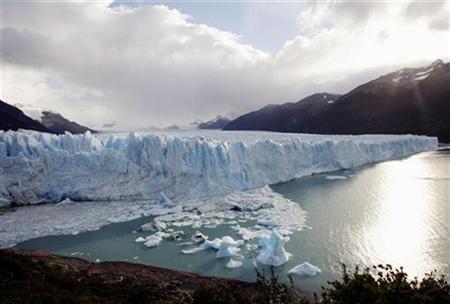Date: 04-Feb-09
Country: ARGENTINA
Author: Laura MacInnis

Defiant
Argentine Glacier Thrives Despite Warming Photo: Enrique Marcarian
Photo: Enrique Marcarian
LOS GLACIARES NATIONAL PARK - Climate change appears to be helping
Argentina's mighty Perito Moreno glacier, which is thriving in defiance of
the global warming that is shrinking its peers.
While most of the world's glaciers are melting away because of warmer
temperatures, scientists say the Perito Moreno ice field, known as "The
White Giant", is gaining as much as 3 meters (10 feet) a day in some parts,
pushed forward by heavy snowfalls in the Patagonia region.
"Glaciers don't respond solely to temperature changes," said Martin Stuefer,
a Patagonian expert from the University of Alaska Fairbanks.
He said the area's heavy precipitation has apparently increased along with
the world's recent climatic shifts, combining with strong, cold Patagonian
winds to reinforce the glacier.
"Climate change is not the same everywhere," Stuefer said by telephone from
Alaska.
The creaking Perito Moreno is one of the largest glaciers in South America
and by far the most famous because it is so accessible to tourists despite
its location about 3,000 km (1,900 miles) southwest of Buenos Aires.
Visitors crowd onto boats and viewing platforms to see the 30 km-long (18
mile-long) glacier noisily hurl huge blocks of blue-tinged ice into Lake
Argentino.
Scientists say nearly 90 percent of the glaciers in Antarctica and Patagonia
-- at the southern tip of South America -- are melting quickly. The same is
happening in the Arctic, the Andes, the Alps, the Himalayas and elsewhere in
response to climate change linked to human activity.
The average melting rate of the world's mountain glaciers has doubled since
the year 2000, the U.N. Environment Programme and the World Glacier
Monitoring Service said in a recent report.
Melting glaciers threaten to cause rising sea levels and dry up steady
sources of fresh water that people now depend on for farming, drinking and
even hydropower.
But glaciers are also affected by other factors such as snowfalls, winds,
altitude and shade, and the Perito Moreno is among the few resisting the
broad trend.
"A small percentage seems to be doing strange things," David Vaughan, a
British Antarctic Survey glaciologist and member of the United Nations
climate panel, said by telephone from a field mission in Antarctica. "The
odd 13 percent are either stable or advancing a little."
There are limits to the Perito Moreno's aggressive advance, however. It
periodically reaches as far forward as it can toward the Magallanes
Peninsula and then sheds a large section of its front in a spectacular
phenomena known as "la ruptura," or the rupture.
More than 190 governments have agreed to work out by the end of 2009 a new
U.N. treaty to rein in fossil fuel emissions and slow global warming,
fearing that rising seas could swamp low-lying islands or flood coastal
cities from Amsterdam to Sydney.
(Editing by Fiona Ortiz and Kieran Murray)
© Thomson Reuters 2009 All rights reserved
